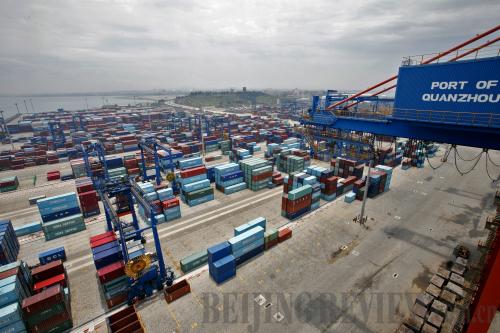|
 |
|
A NATURAL HARBOR: The Shihu Harbor in Quanzhou, Fujian Province, bustles with business on May 12, 2014. The harbor has a history of more than 1,500 years and was one of the starting points of China's ancient Maritime Silk Road (SHEN BOHAN) |
China's going-out development strategy is manifested most through the One Belt and One Road initiatives. The Silk Road Economic Belt and the 21st Century Maritime Silk Road, both put forward by Chinese President Xi Jinping in 2013, signify China's commitment to further opening up its economy and revitalizing the ancient Silk Road in a mutually beneficial fashion, experts say.
Cooperation potential
The Maritime Silk Road dates back to 2,000 years ago, when ancient merchants sailed from China's eastern coast, passing Southeast Asia, the southernmost tip of India and East Africa, all the way to the Persian Gulf and the Red Sea, strengthening economic ties and cultural communication of the regions along the route.
The new Maritime Silk Road is expected to further communication and cooperation between China and the countries and regions along the route through trade, investment, cultural and currency exchanges.
"Compared with the Silk Road Economic Belt, the Maritime Silk Road is of more significance," said Mei Xinyu, a senior researcher at the Chinese Academy of International Trade and Economic Cooperation, a think tank affiliated with the Chinese Ministry of Commerce. "The route originates from China's backyard, where it has relatively matured economic and trade ties with ASEAN members. The new concept will help upgrade trade ties."
Wang Xiaopeng, an expert on maritime and border studies at the Chinese Academy of Social Sciences (CASS), said that the initiative could help China and its partners build strategic trust and manage disputes through breakthroughs in the economic sphere.
"Politicians in those countries will have to get bilateral ties back on track, because they can't afford the consequences of missing out on opportunities provided by China's growth," Wang said.
"All in all, the initiatives are two programs of the grand going-out strategy adopted by China in recent years," said Xu Hongcai, Director of the Department of Information under the China Center for International Economic Exchanges, a Beijing-based think tank.
The initiative to build the 21st Century Maritime Silk Road was proposed by President Xi during his visit to Indonesia in October 2013 to deepen economic and maritime links and integrate all the existing cooperation mechanisms among the countries along the route.
"With China playing a more important role in global trade, the new Maritime Silk Road will be a new type of trade route linking China and the rest of the world in a new globalized era," said Han Feng, Deputy Director of the CASS' National Institute of International Strategy.
Zheng Yongnian, Director of the East Asian Institute of the National University of Singapore, said that the new Maritime Silk Road will open new ship routes for increasing the flow of goods, information, tourists, students, businesses, technologies and scientific knowledge between China and many other countries.
"It will open the door for China to go to the rest of the world, after more than 30 years of reform and opening up and inviting foreign business in," Zheng said, adding that going out will be a major theme for Chinese capital in the coming years.
Chang Jian, Barclays' chief China economist, said that the initiative will create trade and investment opportunities in infrastructure and construction, including transportation, ports, pipelines, power generation and environmental projects, as well as stimulating energy and resource exchanges, consumption and tourism.
"We think the initiative is underpinned by a mutually beneficial approach and a strong desire from China to export excess capacity, invest abroad and diversify its foreign exchange reserves. China has competitive edges in capital and expertise, while many Asian countries face large financing gaps," Chang said.
She said that the establishment of the China-led Asian Infrastructure Investment Bank (AIIB) in October last year demonstrated the regional desire to cooperate. With authorized capital of $100 billion, the AIIB will be up and running before the end of 2015.
| 